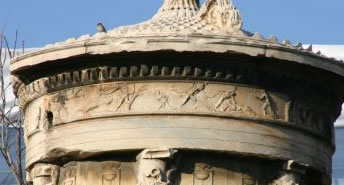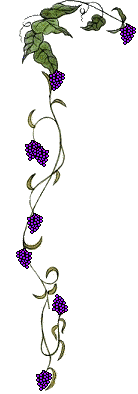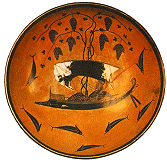


Defeats Captors, Creates New Species
By Bob Lee
A chaotic scene ensued on the open sea today, when pirates kidnapped Dionysus (also known as Bacchus), one of our most beloved gods.
There were very few people remaining who witnessed these events, with slightly conflicting stories.
The helmsman of the ship, Acoetes of Maeonia (Ovid 102), is the only member of the pirate crew to survive… sort of. According to Acoetes, he and the rest of the pirates stopped at the bay of Chios to stay the night. They beached their ship, and the next morning some of the crew members caught what appeared to be a young boy, stumbling around in a drunken haze. But there was something about this boy that made Acoetes think he was actually a god. "I looked upon his face, his dress, his walk; The more I saw the more he seemed immortal," he said.
Acoetes warned his shipmates about his feeling that their prisoner was a god, but they didn’t listen, he says. Acoetes told the prisoner, "I do not know what magic stirs in that beauty, but I do know this: It is divine. Whoever you may be, give us good fortune and forgive these men" (Ovid 103). The rest of the crew objected to this, and they all fought with the helmsman.
One member of the crew almost killed him, when Dionysus came to his senses. Dionyus "woke up and said, ‘What’s this upheaval, cheers? Tell me, O sailors, how did I come here, and what do you propose to do to me?’" (Ovid 104). One of the crew told him not to worry and asked Dionysus where he wanted to go. Dionysus told him he wanted to go to Naxos, where he said he lived. Acoetes was steering and directed the ship toward Naxos, when the other members of the crew began to yell at him, telling him he was going the wrong way. One of them managed to get the rudder from the helmsman and steered the ship in the opposite direction.
At this point, according to Acoetes, Dionysus pretended to cry. "Then the god to trick them, as if he had just learned of his falsity, looked out to sea from the curved stern and wept: ‘O sailors, where is land you promised me? This is not where I’d go; what have I done? Where is the honour of this great deceit of a mall boy and all of you against one?’ I had been weeping and all the wild impious crew laughed at my tears" (Ovid 104).

This is when the ship stopped moving, according to Acoetes, and something very unusual began to happen. "The men increased their efforts at the oars, spread out full sails to speed their way at double power, but vines grew fast around each oar, and, growing, climbed among the sails and hawsers, even decks were overhung with grape and vine" (Ovid 105). Then, Dionysus appeared, wearing a crown of leaves and grapes, waving a wand. Dionysus was surrounded by large jungle cats, Acoetes says: a tiger, a lynx and a panther. Then, everyone but the helmsman jumped overboard, and they immediately began to change shape. Their backs hunched over, their arms and legs turned into fins and tails, they grew snouts and they turned deep blue in color.
Of the twenty crew members, Acoetes was the only one who survived and kept his original form. "I was the last one left, senseless and shaking with chilled fear," he said. "And, as if to steady me, the god said, ‘Now strike swift, set sail for Naxos.’ And when we landed I was priest of Bacchus" (Ovid 105).
A man named Hughes told me the same story, except Dionysus didn’t have a wand after the grapevines took over the ship, but a javelin (Hughes 182). I found out later that Hughes heard the story second-hand, so would probably not be as reliable as Acoetes’ story. Besides, it isn’t clear why he would have needed a javelin. It seems that a wand would have been more suitable for this particular occasion. But, our gods do tend to work in mysterious ways.
Another eye-witness, who wishes to remain anonymous, also had a similar account of the kidnapping. According to this witness, however, the pirates didn't stay the night on the beach to find Dionysus the next day, as Acoetes contends, but saw him from the ship as they approached the land. Once they had beached their ship, the pirates seized Dionysus and quickly sailed away.
This anonymous witness offered a possible explanation of the pirates' motivations for kidnapping Dionysus—that "they thought he was the son of one of Zeus's favorite kings" (Hymn 278). This would allow them to hold him for ransom. The witness then said the pirates tried to tie Dionysus up with willow ropes, which immediately fell off of him.
At that point, Dionysus smiled at the pirates, according to the witness. It was then that the helmsman objected, this witness said, contrary to the helmsman's version of the story, which says he tried to stop them from bringing Dionysus on the ship. "The helmsman saw this, he immediately cried out, he screamed out to his men: 'You fools! What powerful god is this whom you've tied up? Not even our ship, sturdy as it is, not even our ship can carry him. Either this is Zeus, or it's Apollo, the silver-bow, or else it's Poseidon! He doesn't even look like a person, he's like the gods who live on Olympus. Come on! Let's unload him, right now, let's put him on the dark land. Don't tie his hands or he'll be angry, he'll draw terrible winds to us, he'll bring us a big storm!" (Hymn 279).
The witness then went on to tell me the captain of the ship disagreed with the helmsman, and began to sail the ship away. This also contradicts the helmsman, who said that he was the one steering the ship at first and made no mention of a captain.
Another difference in this witness' story is that Dionysus never told the pirates where to take him. The captain started the ship without any instructions. In addition, the witness didn't indicate that he saw Dionysus or the helmsman crying.
The witness agreed with the account of the grapevines covering the ship, but added that before the vines appeared, the ship overflowed with wine. And not only was the ship enveloped with grape vines, but the oar-locks turned into garlands. The pirates then appealed to the helmsman, asking him to get them back to land. It isn't clear why the captain wasn't still steering the ship at this point.
Here, our witness' story is much different from the helmsman's. According to this witness, there were no images of jungle cats around Dionysus, but Dionysus himself turned into "an awful lion high up on the ship," and he roared at the crew. The witness didn't mention a crown of ivy, a wand or a javelin. Dionysus did, however, produce one dangerous animal for the crew to contend with: "a bear with a furry neck," which "made gestures" and "threatened" them. The crew rushed around the helmsman, when Dionysus, as the lion, pounced on the captain, the witness says. "Everybody fled to the stern, they panicked, they ran to the helmsman, because the head of the helmsman was cool. But the lion, suddenly, leaped up, it seized the captain!" (Hymn 280).
The two stories begin to cohere at this point, as the rest of the crew jumped overboard and turned into the same sort of sea creatures the helmsman described. The witness called the creatures they turned into "dolphins" (Hymn 280).

|
After interviewing our anonymous witness, I found another man named Lysicrates, who I was told knew something about the pirates’ attack. When I found him, he wouldn’t tell me anything, but insisted on showing me what happened by building a large monument and carving the scene into stone. His carving illustrated a much different story from what I had heard. From what I can tell from the carving, these events didn’t take place on a ship at all, but on the beach. If this carving is accurate, there was no grapevine that overtook the ship. Instead, it looks as if Dionysus summoned a group of satyrs to fight the pirates. Some of them must have already jumped into the sea, as there were two dolphin-men depicted, but the rest were busily fighting the satyrs. According to the carving, Dionysus did not seem to have been involved in the fight very much, as the carving shows him sitting on a rock, petting a panther, with a few relaxed-looking satyrs loitering nearby. It is possible that this scene occurs after the fight, however.
The apparent contradictions in these stories are troubling, but the witnesses did not respond to requests for follow-up interviews, unfortunately.
It is clear, however, that pirates kidnapped Dionysus; the helmsman at some point warned them to let him go; and they didn’t listen, causing Dionysus to turn all of them but the helmsman into dolphins. And there was a wild cat of some type involved. Lysicrates’ carving didn’t include the ship and the giant grape vine, but the other three accounts seem to be certain that the conflict took place onboard the ship, and there was indeed a giant grape vine. Also, Lysicrates, like Hughes, learned about it second-hand.
Dionysus certainly is an incredible god to have done so much. We all owe him our admiration and respect.

Works Cited
Hughes, Ted. Tales From Ovid. New York: Farrar, Straus and Giroux, 1997.
"Hymn to Dionysus." Classical Mythology: Images and Insights.
Lysicrates. Choragic Monument of Lysicrates. Athens, Greece.
Ovid. The Metaporphoses. Trans. Horace Gregory. New York: Penguin, 1958.